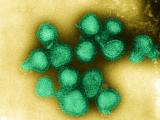(CIDRAP Business Source Osterholm Briefing) – Reports are emerging rapidly about a new strain of influenza that has infected seven adults and children in the southwest region of the United States. This swine influenza strain of H1N1 is different from the human strain of H1N1, and the current human vaccine would likely offer little protection.
This development has captured the riveted attention of experts and flu watchers, many of whom are more concerned about a possible pandemic than they have been since the early days of H5N1. The Centers for Disease Control and Prevention (CDC), however, has so far declined to speculate on whether it is worried about the pandemic potential of the new virus, and the mainstream media have so far followed the CDC's lead and downplayed the story.
We want to make sure you are getting the most current, reliable, and authoritative intelligence as this event unfolds. We will provide you ongoing updates, around the clock if necessary.
What follows are the most important points you need to know at this moment. Dr Osterholm, Director of the Center for Infectious Disease Research & Policy (CIDRAP), is an advisor to national and international public health agencies, someone who has led numerous outbreak investigations, and is the Director of the National Institutes of Health–sponsored Minnesota Center of Excellence for Influence Research and Surveillance. Dr. Sandman is a world-renowned risk communication consultant who has advised the World Health Organization (WHO) and the CDC, among many others. We want to share with you our take on the current situation.
1. How concerned should you be?
We should be concerned about these cases in the United States, especially in light of the fact that something is causing severe respiratory illness (SRI) in parts of Mexico. While we don't know what is causing the illness in Mexico, if it is related to the current swine influenza situation, this is a very serious concern. This afternoon, the CDC noted that ". . . concern exists that this new strain of swine influenza A (H1N1) is substantially different from human influenza A (H1N1) viruses, that a large proportion of the population might be susceptible to infection, and that the seasonal influenza vaccine H1N1 strain might not provide protection."
So, yes, we should definitely be concerned about this situation; the billion-dollar questions is how concerned. At this time we just don't know and likely won't know for a while if this new influenza virus could be responsible for the next influenza pandemic. Current investigations by a number of public health agencies are beginning to shed light on the meaning of these cases. Hold on. This could be a long and bumpy ride.
By way of background, we urge you to read this article in the CDC's publication Morbidity and Mortality Weekly Report and the CIDRAP News article published late this evening.
The H1N1 influenza virus causing this illness is considered a swine influenza virus because one critical part of the virus comes from influenza isolates usually found only in swine. However, the virus is unique in that it has genes from four different sources: (1) North America swine influenza, (2) North American avian influenza, (3) human influenza, and (4) Euro-Asian swine influenza. We refer to this type of isolate as a "quadruple reassortment." This particular H1N1 swine reassortment strain has not been identified before now. However, quadruple reassortment in H1N1 is not unprecedented.
We know very little at this point about this virus and where it originated in terms of animal species and geographic location.
2. Could this virus cause a pandemic?
Possibly—we don't know yet. Remember that H1N1 caused the 1918 pandemic. And for over 30 years, a strain of H1N1 has been present among humans as a seasonal flu strain. Each year we include this strain in our current seasonal influenza vaccine. What we don't know is if this new strain has the potential to cause the next pandemic.
To launch a pandemic, an influenza virus must be a novel strain that humans have no defenses against, it must cause serious illness, and it must be readily transmissible from human to human. We know this new swine flu virus is novel; so far it seems a lot milder than H5N1, but it's capable of becoming serious.
What we don't know yet is how readily transmissible it is from human to human. The seven cases identified so far had no known contact with pigs, and the seven cases include two pairs (two children from the same school and a father-daughter combination). So human-to-human transmission is obviously part of the picture. But are the chains self-limiting? Is the virus hard to catch? Or will it start spreading widely and rapidly?
So for now we must assume that it could. The possibilities are that the new H1N1 strain could:
- Result in only limited human-to-human transmission and disappear as quickly as it came
- Persist in the human population with ongoing human-to-human transmission for a limited time, but not cause the next pandemic
- Circulate for months to years and eventually emerge as the next pandemic strain
- Already be the next pandemic strain beginning to emerge
While this uncertainty is very troubling, it's the reality we face today.
3. Are these outbreaks linked to reports of severe respiratory illness in Mexico?
Mexican health officials have reported two clusters of a severe respiratory illness (SRI) this month in Mexico City (120 SRI cases, including 13 reported deaths) and in San Luis Potosi (14 SRI cases, including 4 deaths). In addition, one death has been reported in Oaxaca (southern Mexico) and two in Baja California Norte (bordering the state of California). Most cases were previously healthy young adults, ages 25 to 44; some healthcare workers have been affected as well. Patients had high fever, headache, eye pain, shortness of breath, and extreme fatigue with a rapid progression of symptoms to severe respiratory distress in about 5 days.
As we noted before, we do not know if the illnesses in California and Texas are related to the outbreaks in Mexico. If they are related, however, the seriousness of these outbreaks will lead to a much higher level of concern. We will let you know as soon as we learn anything new.
4. How are national and international leaders responding?
There is no official change at this point in the WHO pandemic phases. Based on conversations both of us had today, we can tell you that both formal and informal high-level discussions are taking place regarding whether to raise the level to phase 4, indicating "evidence of increased human-to-human transmission" of the virus.
In Indonesia in 2006, several clusters of H5N1 outbreaks occurred. The phase was not changed at that time. Unless additional information emerges that supports the ongoing transmission of this new H1N1 strain among humans, or tests show that the current Mexican illnesses are related to this virus, we don 't believe the WHO will raise the level to phase 4.
5. Will we see new cases?
It is very possible that we will see more cases. However, this does not mean the situation is worsening. New cases could be residual to the current outbreak, so we must be careful about interpreting numbers. We will keep you posted. We are truly in limbo at this moment. This could be nothing, or it could be the beginning of a pandemic.
6. Should you lower your concern level because the new virus is causing mild illness among the cases documented in the United States?
The most reassuring fact about this new virus is that the seven infected patients so far identified have all recovered. The case-fatality rate so far, in other words, is zero. And nobody has yet suggested that hospitals in the San Diego area or elsewhere are inundated with respiratory disease cases. Either there aren't a lot of cases of the new swine flu yet, or they're nearly all mild.
Don't rely too heavily on the mildness of the first seven cases. One of them was severe enough that the patient needed to be hospitalized—and 1 in 7 hospitalizations is already more severe than a typical seasonal flu.
More important, early mildness isn't guaranteed to remain stable. The first wave of the 1918 pandemic, which was caused by H1N1, resulted in only mild illnesses, but the second wave was a killer. This situation is likely to be highly volatile in the next days and weeks. This is a time of great uncertainty.
7. What should you do right now?
Now is the time to go back to your pandemic plan and begin considering the steps you've outlined for response in the earliest stages of the next pandemic. Your executive office should be well aware of this situation and that conditions could change quickly. You must also inform senior management that this situation may not escalate. It may remain stable. It may disappear. We just don't know.
Now is also a good time for managers to sensitize employees to work on their home preparedness plans—stockpiling food, water, batteries, crucial medications, etc. The teachable moment may come and go quickly if this outbreak fizzles out, as we all hope it does. At least use it to stimulate some additional pandemic prep at every level of your business, including the homes of your employees.
Stay focused on the mainstream media sources, and, in some instances, you may want to follow the blog world. Some bloggers may provide information not yet available from government sources. Of course, the problem with all information sources is their reliability and their ability to accurately describe the current situation.
Expect that international and government agencies and the mainstream media will be reluctant to speculate in ways that might be seen as fear-mongering. So if the situation does get worse, they may be slow to say so. The blogs will be quicker—but less reliable. Use the mainstream media as your best source of information about what has happened, and the blogs as your best warning about what might happen. At CIDRAP, we will try to find a happy medium.
That's where we come in: Our job will be to give you the information that you need about both what has happened and what might happen, so you can make critical decisions based on the best available information.
Stay tuned.
Peter M. Sandman,PhD, is a risk communication consultant based in Princeton, NJ, and Deputy Editor of CIDRAP Business Source. His writing on risk communication can be found at www.psandman.com; his pandemic communication writing is indexed at www.psandman.com/index-infec.htm.




















